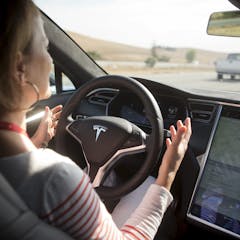
Articles on car culture
Displaying all articles

We accept the daily toll of road deaths and injuries as the price we pay to be able to drive everywhere, but it doesn’t have to be this way.

Early in the pandemic, when there was much less traffic on the roads, people took to their bikes. But since then, fewer people are cycling, with rates now lower than in 2011.

Having a small backyard in outer suburban developments doesn’t make up for everything else that’s missing in these new neighbourhoods.

Uber is eyeing a service to take children wherever their parents would otherwise have to drive them themselves. Some might see it as a lifesaver, but it’s problematic for many reasons.

The Hoddle Grid that dictates the flow of vehicles and people in central Melbourne has had its day. It can be remade to reduce the dominance of cars and create a liveable city for the 21st century.

Seeing Japanese parents send toddlers out on their own to do errands has shocked viewers. But not that long ago our neighbourhoods were also child-friendly, and we can make them so again.

Traffic crashes kill and injure millions worldwide every year and are a major drain on economic development. Improving road safety would produce huge payoffs, especially in lower-income countries.

Many Australians are dog owners but feelings run high over the issue of allowing dogs on public transport. Despite polarised opinions, experience overseas shows how concerns can be managed.

Ford’s electric F-150 pickup won’t roll off assembly lines until early 2022, but the company has received thousands of preorders already for a vehicle aimed at the mass market, not eco-buyers.

Transport is the one sector where Australia hasn’t reined in the growth in greenhouse gas emissions. Electric cars will cut emissions but still leave us with all the other problems of car use.

The utopian 20th-century model of a modern city – one that has been replicated around the world – is being exposed as unsuitable for adapting to the pace of change in the 21st century.

Instead of free parking, our post-COVID CBDs need a big vision to become attractive destinations that aren’t car-friendly at the expense of being people-friendly.

The global trend is to free up valuable city space by reducing parking and promoting other forms of transport that don’t clog roads and pollute the air. Australian cities are still putting cars first.

Traffic impact assessments required of major building developments mainly focus on the movement of cars, but these account for only 30-40% of trips by inner-city apartment dwellers.

New analysis reveals just how little is spent on cycling and walking projects around Australia. No state’s spending on cycling is more than 1.5% of its road funding.

A comparison of Australian cities reveals cyclists and walkers are still very much a minority of commuters, despite the economic, health and environmental costs. Action on three fronts is needed.

Australian cities generally don’t allow pet dogs on public transport. Instead, owners need their own vehicle to travel with their dogs, and it’s a surprisingly important factor in our car dependency.

Planners wish to correct past errors by increasing densities, discouraging car dependency and mixing land uses. But imposing imported strategies on Australian cities is producing unhappy results.

The primacy given to the car has shaped our cities, the roads that serve them and our very thinking about the place of driving in our lives. And it’s a mindset that leaves cyclists highly vulnerable.

A thought experiment: how will people view mobility and personal vehicles once we have electric, autonomous vehicles in the future?
